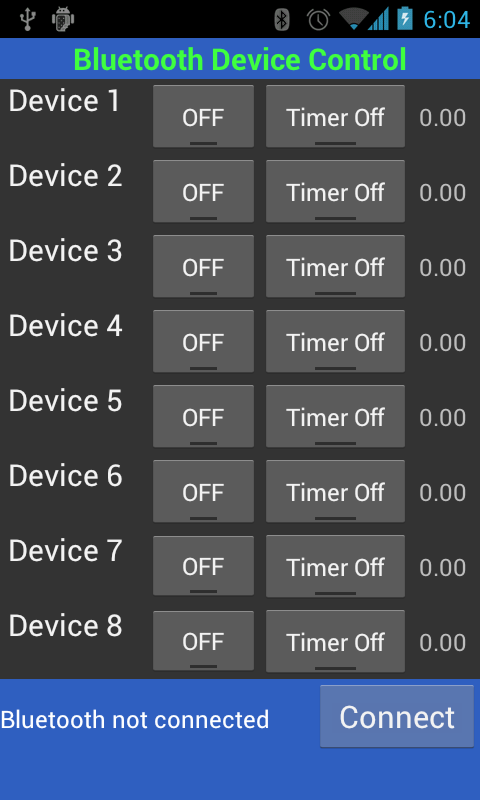
Program Arduino Over Bluetooth
Upload sketches to your Arduino wirelessly with a DIY Arduino Bluetooth Programming Shield. Program the Arduino With Bluetooth! Power on the Arduino from a battery or AC adapter. Save over 40% off the annual cover price! One Year (6 issues) SUBSCRIBE TO MAKE: MAGAZINE. In some projects it would be really handy to program the Arduino wireless, so in this instructable I'm going to show you how to program an Arudino wireless over Bluetooth, so you don't have to carry an extra USB cable again or unplug the Arduino from the project just to upload the new code.
Arduino BT (Bluetooth) Arduino BT Front Arduino BT Back Overview The Arduino BT is a microcontroller board originally was based on the ATmega168, but now is supplied with the 328P () and the Bluegiga WT11 bluetooth module ( and [pdf]). It supports wireless serial communication over bluetooth (but is not compatible with Bluetooth headsets or other audio devices). It has 14 digital input/output pins (of which 6 can be used as PWM outputs and one can be used to reset the WT11 module), 6 analog inputs, a 16 MHz crystal oscillator, screw terminals for power, an ICSP header, and a reset button. It contains everything needed to support the microcontroller and can be programmed wirelessly over the Bluetooth connection. Instructions are available for. Summary Microcontroller ATmega328P Operating Voltage 5V Input Voltage 2.5-12 V Digital I/O Pins 14 (of which 6 provide PWM output) Analog Input Pins 6 DC Current per I/O Pin 40 mA DC Current for 3.3V Pin 500 mA (with a 1.5A capable power source) DC Current for 5V Pin 1000 mA (with a 1.5A capable power source) Flash Memory 32 KB (of which 2 KB used by bootloader) SRAM 2 KB EEPROM 1 KB Clock Speed 16 MHz BT Module 2.1 WT11i-A- AI4 Schematic & Reference Design Reference Design: Schematic: Power The Arduino BT can be powered via the V+ and GND screw terminals. The board contains a DC-DC convector that allows it to be powered with as little as 2.5V, a maximum of 12V.
Higher voltages or reversed polarity in the power supply can damage or destroy the board. The protection for reverse polarity connection is ONLY on the screw terminal. The power pins are as follows: • +VIN. The input voltage to the Arduino board (i.e. The same as the V+ screw terminal). You can supply voltage through this pin, or, if supplying voltage via the screw terminals, access it through this pin. Warning: The protection for reverse polarity connection is ONLY on the screw terminal, do not attach negative voltages to this pin.
It will damage the board. This pin outputs a regulated 5V from the regulator on the board. The board can be supplied with power either from the screw terminal (2.5V - 12V) or the VIN pin of the board (2.5V-12V). Supplying voltage via the 5V or 3.3V pins bypasses the regulator, and can damage your board. We don't advise it.
Memory The ATmega328P has 32 KB of flash memory for storing code (of which 2 KB is used for the bootloader). It has 1 KB of SRAM and 512 bytes of EEPROM (which can be read and written with the ). Input and Output Each of the 14 digital pins on the BT can be used as an input or output, using,, and functions. They operate at 5 volts. Each pin can provide or receive a maximum of 40 mA and has an internal pull-up resistor (disconnected by default) of 20-50 kOhms. In addition, some pins have specialized functions: • Serial: 0 (RX) and 1 (TX). Used to receive (RX) and transmit (TX) TTL serial data.
These pins are connected to the corresponding pins of the Bluegiga WT11 module. Flexisign-pro 8.6 cracked feet. • External Interrupts: 2 and 3. These pins can be configured to trigger an interrupt on a low value, a rising or falling edge, or a change in value. See the function for details. • PWM: 3, 5, 6, 9, 10, and 11. Provide 8-bit PWM output with the function.
• SPI: 10 (SS), 11 (MOSI), 12 (MISO), 13 (SCK). These pins support SPI communication, which, although provided by the underlying hardware, is not currently included in the Arduino language.
• BT Reset: 7. Connected to the reset line of the Bluegiga WT11 module, which is active high. There is a built-in LED connected to digital pin 13. When the pin is HIGH value, the LED is on, when the pin is LOW, it's off. The BT has 6 analog inputs, each of which provide 10 bits of resolution (i.e.